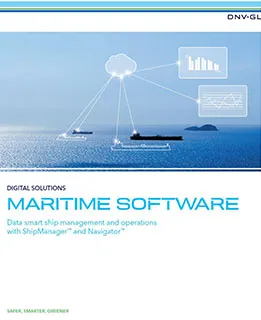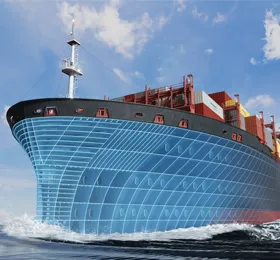With the advances in software systems for shipping in recent years, there is a vast trove of data that can provide business advantages if analysed correctly and communicated efficiently in real-time to decision makers, whether on shore or on board.
Business advantages
The lack of proper inspection regimes and systems can lead to a situation such as the following real case. During ballasting of a ship in port, a thin oil film appeared on the sea surface. Heavy fuel oil had leaked into a ballast tank through a corroded bulkhead. Port authorities required immediate action and the ship was detained for repair, incurring high costs. With proper follow-up of inspection regimes and well-implemented hull-integrity software solutions, the risk of such an incident is minimal. Inspections – including cross-fleet analysis – have the potential to provide significant savings, including in connection with dry-docking. An operational hull planned-maintenance system based on bestpractice procedures will improve asset management and give more predictable maintenance costs. Regular, scheduled inspections following these practices allow potential problems to be discovered at an early stage. They also bring the benefits of immediate access, after one-time data entry, to status and repair data (ongoing and historical) supported by 3D ship-specific models. There is no need to collect information from various paper and multiple-data sources, a process which can be complicated and time-consuming.
Transparency and continuous control of a ship’s hull condition create business advantages for ship operators and owners. Shipping companies can present a charterer or vetting inspectors with immediate documentation showing that proper technical and risk management systems are in place, supporting the securing of new contracts, not to mention helping to achieve a higher price when the ship is being sold.
Safety and profitability
Since the introduction of the ISM Code, owners are obliged to carry out regular inspections of their ship’s hull and equipment. The crew is often responsible for this and it is crucial that they have the necessary knowledge and skills. The quality and value of any inspection scheme is highly dependent on the qualifications of the inspectors.
DNV has developed hull structure and inspection courses tailored to cover what is needed in order to carry out hull inspections. The courses have been developed by experienced naval architects and ship surveyors and take a basic, practical approach using the 3D Survey Simulator to illustrate hot spots and increase understanding of the structural configuration and response of ship structures. In addition, DNV provides ship-specific hull inspection manuals offering detailed guidance on critical areas and evaluation.
DNV hull-structure expertise
To identify the critical areas, DNV’s broad general experience of ship classification is shared with owners by hull experts dedicated to looking after ships in operation. Furthermore, the level of detail regarding the rating of the coating condition, type of breakdown, how to report structural deficiencies, etc, is specifically tailored.
The hull inspection is not completed until the findings have been properly recorded, and the recordings are of little value unless used by both crew and onshore staff to control the condition of the vessel or fleet and prepare for repairs or dockings. To help do so in a structured, consistent and effective way, DNV offers a fleet maintenance system for ship inspection, ShipManager Hull.
Based on a tailored 3D structural model of the vessel available both on board and on shore, ShipManager Hull facilitates easy communication through a fully interactive 3D model which enables specific findings to be pinpointed using attached photos, drawings, etc. Cross-fleet analysis allows comparison between sister vessels. Thickness measurements can be visualized with measurement points that show the actual condition, supporting the planning of steel renewal. Steel weight calculations for repairs (including surface area and steel grade) based on an area marked on the model improve repair planning and the budgeting of dry-docking projects.
Smart management of dry-docking
The ShipManager Projects software system provides planning, tendering and project management help for dry-docking and other projects. It will enable you to manage a complete dry-docking project from work item collection via quotations management to the actual dry-dock work. You can easily re-use groups of work items or templates for types of work and build an electronic knowledge library for your dry-docking projects.
This system makes life easier for the crew, who can take advantage of graphical navigation aids, pre-defined inspection sheets that match the inspection manual and the automated transfer of inspection recordings to the central database on shore. The status of the inspection schedule and condition control can be seen immediately from colour-coded severity alarms that are also displayed graphically. This facilitates a proactive maintenance environment in which superintendents or fleet managers can act quickly, based on a full set of consistent condition data.
Hull integrity challenges
DNV has extensive experience of providing hull integrity software and services for all types of vessels. One example is oil tankers, where cracks, corrosion and other elements of structural integrity are main areas of attention. The lack of satisfactory hull integrity may lead to oil ingress in ballast tanks, pollution of the sea, port state detentions, fines, unscheduled ship repairs and, in the worst cases, major accidents due to structural failure. This is also the reason why hull integrity receives such a lot of attention from charterers in connection with vetting. TMSA compliance is necessary in order to obtain acceptance by charterers.
The main hazards for liquefied gas (LNG/LPG) transport are high pressure, low temperature, flammability, toxicity and reactivity. Cracks, corrosion and other structural integrity elements are also main areas of attention. Regarding the cargo-containment system itself, gas carriers have a good record in terms of safety. However, damage statistics clearly show that gas carriers suffer from the same challenges as other tankers when it comes to the structural integrity of the hull itself. Coating breakdown, e.g. in welding connections, can cause a dramatic reduction in fatigue life. It is important to discover and monitor coating breakdown at an early stage.
In FPSOs, signs of ageing with a potential impact on normal operations (e.g. corrosion, buckling and fatigue) lead to a need for systematic hull integrity management activities such as inspection, monitoring, maintenance and repair work. With hull integrity systems in place, owners are able to focus on life extension, preventing any negative impact on the environment, minimizing operational downtime and maximizing asset value.
Contact:
Stefan Fröbe, Marketing and Communication Manager Ship Product Line


